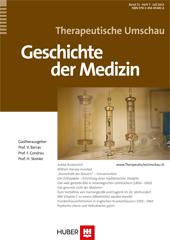Krankenhausinfektionen und Antibiotikaresistenzen in englischen Krankenhäusern 1930 – 1960
Abstract
Zusammenfassung. Dieser Aufsatz untersucht die Geschichte von Krankenhausinfektionen, die Einführung von Antibiotika und die Entdeckung der Antibiotikaresistenzen in englischen Krankenhäusern zwischen 1930 und 1960. Infektion erwies sich als fast konstantes Problem für das moderne, kurative Krankenhaus. Die Einführung von Sulfonamiden und später von Antibiotika bot eine kosten-effektive, gut verfügbare Gegenmassnahme, die zumindest kurzfristig sehr erfolgreich war. Die längerfristigen Konsequenzen waren allerdings weniger günstig, da schon früh resistente Keime im Krankenhaus auftraten. Rufe nach einem rationalen Umgang mit Antibiotika verhallten ungehört, stattdessen eskalierte das Problem. Der Schock von Staph 80/81, ein gegen alle damals verfügbaren Antibiotika resistenter Keim, sowie die Grippepandemie von 1957/58 beschleunigte die Entwicklung von Methicillin sowie die Durchsetzung strengerer Infektionsprophylaxe im Krankenhaus. Das Problem der Krankenhausinfektionen verschwand dann vorläufig von der Bildfläche.
Abstract. This paper examines the history of hospital infections, the clinical introduction of antibiotics and the emergence of antibiotic resistant disease strains in English hospitals between 1930 and 1960. It argues that infection has been an almost constant problem for the modern, curative hospital. The arrival first of sulphonamides and later of antibiotics provided a cost-effective, readily available counter-measure which proved to be highly effective in the short term. The longer term consequence, however, was the emergence of antibiotic resistant strains. Calls for a rational use of antibiotics, voiced from 1952, remained unheard. The problem culminated in the crisis around Staph 80/81, a strain of Staphyloccocus Aureus resistant to all available antibiotics at the time. The development of methicillin and the implementation of stricter infection control regimes allowed the problem to recede around 1960 after an intense period of historical change from the end of the war onwards.



